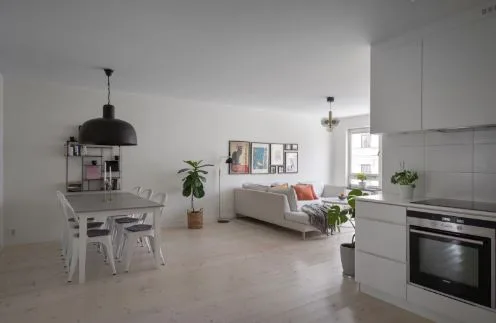Smart Living Redefined Integrating Comfort: Top Trends and Innovations
Modern smart home technology is transforming luxury living by enhancing comfort and convenience in unprecedented ways. The evolution from concept to reality has brought about a new level where our homes are not just places we live, but environments that actively work to improve our quality of life. Imagine walking into a room where the lights adjust to your mood, the temperature is always just right, and your security systems are constantly monitoring your environment—all managed seamlessly through integrated systems.
At the heart of this transformation are several key technologies:
- Artificial Intelligence (AI), which allows devices to learn user preferences and automate tasks accordingly.
- The Internet of Things (IoT), which forms the backbone of this technology by enabling smart devices to communicate and interact with each other.
- Voice control through virtual assistants like Amazon Alexa and Google Assistant, enhancing user accessibility and making it easier to manage household systems.
Moreover, the integration of smart home technology plays a crucial role in promoting sustainable living. Smart homes emphasize energy efficiency and reduced environmental impact, offering not just luxury but also ethical, planet-friendly choices that contribute to a better world and future that was created, including optimized energy use within a network. The paramount focus on these elements ensures a holistic approach to modern living, fostering peace and power.
Creating a Home That Reflects Your Lifestyle
Designing a home that mirrors your lifestyle involves:
- Creating spaces that meet practical needs while aligning with personal values and aesthetic preferences.
- Prioritizing eco-friendly materials, which have become important for homeowners committed to sustainability in 2025.
- Incorporating biophilic design elements, such as indoor plants and abundant natural light, to enhance well-being and connect residents with biodiversity and nature.
Personalization is another key trend, as savvy homeowners invest in custom furniture and decor that reflect their unique tastes. Multi-purpose furniture is particularly popular, combining functionality with style to create living spaces that are both comfortable and efficient. Here, smart home technology integrates seamlessly into decor, enhancing comfort and efficiency without disrupting aesthetics.
Firms like Paulconradarchitects are at the forefront of this movement, incorporating user habits, family needs, and plans for future expansion into their designs. They ensure that every aspect of the home reflects the lifestyle of its inhabitants, from the layout and materials to the integration of cutting-edge smart home technology. This approach ensures that form and function go hand in hand, creating homes that are both beautiful and practical, with a focus on the needs of the residents.
Sustainability as a Core Design Principle
Sustainability has evolved into a core design principle in modern homebuilding. Sustainable architecture emphasizes eco-friendly design that prioritizes energy efficiency and minimal environmental sustainability impact. Utilizing natural lighting and ventilation significantly boosts energy efficiency and reduces dependence on artificial systems.
In locations like Melbourne, the implementation of solar panels has become a prime example of regional solutions driving sustainable change. Sustainable features include:
- Solar panels combined with energy-efficient systems and solar batteries, which drastically reduce a building’s energy requirements and carbon footprint.
- Green roofs.
- Passive design strategies, which include proper insulation and strategic placement of windows, contributing to a home’s overall sustainability.
These eco-conscious homes not only benefit the environment but also provide financial advantages for homeowners by lowering utility costs over time. As the demand for sustainable living continues to rise, such homes are increasingly valued in the real estate market. This shift towards sustainable development is a testament to the growing awareness of environmental impacts and the commitment to global sustainability, making them a cost-effective choice for many, especially with the growing accessibility of solar panels in Melbourne.
Technology and Comfort in the Modern Home
Technology and comfort go hand in hand in the modern home, thanks to the seamless integration of smart devices. Automated systems allow users to control lighting, temperature, security, and entertainment with ease, making daily living more efficient and enjoyable. Imagine adjusting your room’s climate or dimming the lights with a simple remote control voice command, all while your favorite music plays in the background.
Smart appliances such as thermostats and smart lights lighting systems adapt to user behavior, offering exceptional convenience. These devices learn your preferences and adjust settings to keep your home environment optimized for comfort. For instance, smart thermostats can maintain the perfect temperature based on your schedule, saving energy and enhancing comfort simultaneously.
High-performance tech like sophisticated laptops from brands such as Razer supports both work and play in a smart environment. These devices are not only essential for productivity but also enhance the overall smart living experience. Flexible spaces and statement lighting further elevate the design, making modern homes not only functional but also aesthetically pleasing and adaptable to changing lifestyle needs.
Designing with Style and Purpose
Designing with style and purpose involves creating spaces that are both beautiful and functional. A key trend in recent years is the incorporation of bold marble elements, which add a dramatic touch and reflect luxury. Stripes are also making a comeback, providing a nostalgic feel and enhancing the dimensionality of styles.
Nostalgic design allows individuals to draw inspiration from personal memories, often incorporating retro materials and Art Deco elements characterized by rich colors and bold geometric shapes. This approach offers a distinct personality to interiors, making each room unique and reflective of the homeowner’s style. Dark wood finishes are favored for their luxurious appeal, maintaining natural aesthetics in design choices.
The ‘limitless luxe’ trend emphasizes creating opulent spaces even in traditionally mundane areas like laundry rooms. Statement rugs, or ‘floor art,’ are gaining popularity as a noncommittal way to introduce personality and color into interiors. These design choices ensure that style does not compromise environmental responsibility, aligning aesthetics with sustainability and functionality.
Integrating Smart Tech for Everyday Ease
Incorporating smart technology into daily life boosts convenience and efficiency in previously unimaginable ways. Voice-activated assistants such as Amazon Alexa and Google Assistant serve as essential hubs for managing multiple smart devices, simplifying daily tasks easier. Smart lighting and heating systems adjust based on user behavior and environmental conditions, providing unparalleled convenience.
Advancements in home technology include:
- Cloud-based cameras, motion sensors, and smart locks offering real-time safety monitoring.
- Smart appliances, such as refrigerators that track usage and washing machines that can be controlled remotely, transforming routine chores into effortless tasks.
- High-performance laptops from brands like Razer that support digital home hubs, enhancing overall efficiency.
A gradual approach to integrating smart technology can ease the transition, focusing first on areas that significantly improve convenience and security. This approach allows homeowners to adapt to new systems gradually, ensuring each addition enhances their quality of life and simplifies daily tasks. As homes evolve with technology, they create intuitive living spaces that enhance both comfort and access to interaction.
Conclusion
In conclusion, smart home technology is redefining how we live by merging luxury with convenience and sustainability. From creating personalized living spaces to integrating eco-friendly materials and advanced technologies, smart homes are setting new benchmarks for comfort and efficiency. Innovations in home automation, smart appliances, and energy management are making everyday tasks easier and more enjoyable.
The future of smart living holds immense promise, offering a sustainable and efficient way of life that aligns with our values and enhances our well-being. By embracing these innovations, we can create homes that are not only beautiful and functional but also ethical and environmentally responsible. Smart living is truly the future of modern life, offering a new level of comfort, efficiency, and sustainability.
Frequently Asked Questions
How does smart home technology enhance convenience?
Smart home technology significantly enhances convenience through the automation of household systems like lighting, temperature control, and security. By utilizing voice-activated assistants and smart appliances, daily tasks become more efficient and tailored to individual preferences.
What are some examples of sustainable design principles in smart homes?
Sustainable design principles in smart homes encompass natural lighting and ventilation, solar panels, green roofs, and energy-efficient systems, all of which significantly reduce energy consumption and environmental impact. Implementing these features contributes to a more sustainable future.
How do smart homes support well-being?
Smart homes support well-being by personalizing environments through features such as climate control and smart lighting, which enhance comfort and facilitate a connection with nature. This deliberate design fosters an overall improvement in residents’ quality of life.
What is the role of AI and IoT in smart homes?
AI and IoT play a vital role in smart homes by enabling devices to communicate and automate tasks based on user preferences. This integration ensures a seamless and efficient living experience.
How can homeowners gradually integrate smart technology into their homes?
Homeowners can effectively integrate smart technology by initially focusing on enhancements in convenience and security, such as smart lighting and heating systems. This gradual approach ensures each addition is meaningful and improves the overall quality of life.




